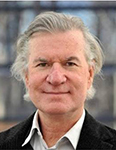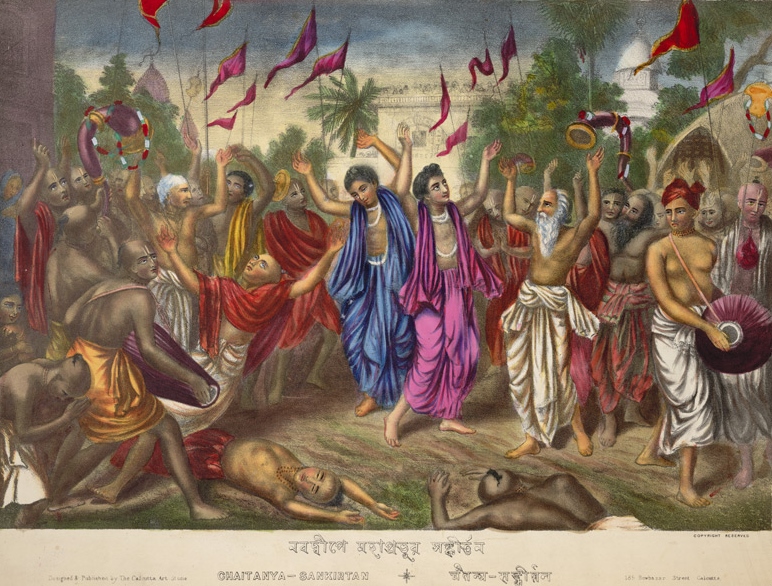Bridging Subfields and Disciplines: John Corrigan on Studying Emotion and Religion
RSN is pleased to publish this interview between John Corrigan and Florida State University PhD candidate Charles McCrary in anticipation of the conference "How Do We Study Religion and Emotion?", to be held February 19–20, 2015, at the National Humanities Center. The conference is free and open to the public. Learn more here.
 John Corrigan (PhD, University of Chicago) is the Lucius Moody Bristol Distinguished Professor of Religion and Professor of History at Florida State University. He is splitting his time in 2014 and 2015 among FSU, as a Fellow at the National Humanities Center, and as the Fulbright Distinguished Research Chair for the Netherlands. He has served as regular or visiting faculty at the University of Virginia, Harvard University, Arizona State University, University of Oxford, the University of London, the University of Halle-Wittenberg, University College (Dublin), as a visiting scholar at the American Academy in Rome, and in the FSU program in Florence. He is the author or editor of over twenty books on American and religious history, the history of emotion, and the spatial humanities. His recent publications are Emptiness: Feeling Christian in America (University of Chicago Press, 2015) and Deep Maps and Spatial Narratives (Indiana University Press, 2015). Forthcoming books include the monograph, Religious Violence and American Foreign Policy (University of Chicago Press); an edited volume, Religion and Atlantic Spaces (University of South Carolina Press); and the coedited book The Business Turn in American Religious History (Oxford University Press). He recently completed a coedited book, Outside the Foxhole: Religion and World War Two. He edits book series for Chicago and Indiana, and is the senior editor for American religion for the Oxford Research Encyclopedia of Religion.
John Corrigan (PhD, University of Chicago) is the Lucius Moody Bristol Distinguished Professor of Religion and Professor of History at Florida State University. He is splitting his time in 2014 and 2015 among FSU, as a Fellow at the National Humanities Center, and as the Fulbright Distinguished Research Chair for the Netherlands. He has served as regular or visiting faculty at the University of Virginia, Harvard University, Arizona State University, University of Oxford, the University of London, the University of Halle-Wittenberg, University College (Dublin), as a visiting scholar at the American Academy in Rome, and in the FSU program in Florence. He is the author or editor of over twenty books on American and religious history, the history of emotion, and the spatial humanities. His recent publications are Emptiness: Feeling Christian in America (University of Chicago Press, 2015) and Deep Maps and Spatial Narratives (Indiana University Press, 2015). Forthcoming books include the monograph, Religious Violence and American Foreign Policy (University of Chicago Press); an edited volume, Religion and Atlantic Spaces (University of South Carolina Press); and the coedited book The Business Turn in American Religious History (Oxford University Press). He recently completed a coedited book, Outside the Foxhole: Religion and World War Two. He edits book series for Chicago and Indiana, and is the senior editor for American religion for the Oxford Research Encyclopedia of Religion.
Charles McCrary: Hi, Dr. Corrigan. Thanks for doing this interview. We're here to talk about your collaborative research grant from AAR for the study of religion and emotion. So, to start, please tell me a little bit about the project, who is involved, and what it entails.
John Corrigan: In the last twenty-five or so years the academic study of emotion has developed strong momentum across the humanities and social sciences. After a slow start among those who study religion (the AAR turned down a request for a Program Unit Group on it in the early 90s but approved one last year), it has reached a critical mass of interest in a number of subfields in religion. The collaborative project, “How Do We Study Religion and Emotion,” is an effort among scholars from different areas of field to think together about what has been accomplished, where the most promising directions currently are, and how we can jointly forge a language that will enable conversation across subfields as well as with other disciplines. To that end, the following are joining me at the National Humanities Center February 19–20: Gail Hamner (Syracuse University), Mark Wynn (University of Leeds), Anna Gade (University of Wisconsin), Donovan Schaefer (University of Oxford), David Morgan (Duke University), June McDaniel (College of Charleston), Diana Cates (University of Iowa), and Sarah Ross (University of Bern). Scholars in religion will attend as well. We are precirculating the papers and intend to publish them in a collection.
CM: I want to ask about the collaborative and interdisciplinary nature of the project, but first we should talk about the object of study. What is “religion and emotion”? And how is studying it different from just studying emotion?
JC: Studying religion and emotion to some extent has involved actively contesting an ingrained view of emotion in the field of religious studies. Centuries of theological arguments about the nature of emotion, which provided much of the discursive setting for thinking about emotion in the West, were attentive above all to what was called “religious experience.” Much of that theology joined intense feeling to profound spirituality and took emotion as an irreducible datum, insusceptible to critical analysis. That is not to say that theological writing about emotion did not become more sophisticated and layered. Rather, it was the reluctance of theological writers to dissect emotion, to critically analyze its representation and performance, and the gravity of the intellectual traditions that promoted that, that frustrated the coalescence of new ways of thinking about emotion in religion. This particular problem has its cognates in other fields, but religious studies has, for complex reasons, just been slow in getting off the dime. The project visible this winter at the National Humanities Center is an effort to figure out how we can study emotion in religion in such a way as to embrace new perspectives, new science about emotion, and issues of gender and ethnicity, for example, while still responding precisely and productively to the theological arguments that remain embedded in much writing about both religion and emotion.
CM: Which theologians and theorists are you thinking about, specifically, who were most important in providing this discursive setting?
JC: Two examples of influential writings that in the last two centuries have offered complex interpretations of emotions as specifically religious emotions—and Christian emotions—would be those by Schleiermacher and Otto. The former’s notion of the “feeling of absolute dependence” as an experience qualitatively different from others enabled its isolation from other aspects of culture, as earnestly as Schleiermacher tried to avoid that. The latter, who proposed the experiences of mysterium tremendum and fascinans tried, like Schleiermacher, to link them to culture, but also failed.
CM: So, would you say that recent interest in religion and emotion attempts to link experience with culture in more convincingly or demonstrable ways? If so, how does this project aim to do that?
JC: Well, I think what most of us in the academic study of religion are doing is trying to figure out, first of all, if we believe in subjectivities, and if so, venture some argument about what that means. That process involves keeping a lot of balls in the air. Some propose that we take subject and object as relative terms, as a relationality rather than defined quiddities. If we try that out as a lead, then the project regarding religion and emotion is less about imagining linkages between experience and culture and more about investigating mutuality in the constitution of emotional life—how biology, social codes, personal circumstance, ideology, status, and other factors are interwoven.
CM: I see. Can you say a little more, then, about the interdisciplinary nature of this project? How do these different approaches work together? How does the study of biology or psychology, for example, provide tools for historians, or represent conflicting methodologies?
JC: The scholars involved represent a wide range of specialties and traditions including anthropology, history, theology, ethics, musicology, literary studies, material culture, philosophy, feminist studies, film studies, Islam, Hinduism, Judaism, Christianity, animal studies, and environmental studies. We talk to each other about emotion. Each person has their own take on affect theory, theories of emotion, and cultures of feeling. Ideally, we are going to find out during the conference what our common ground is and what is likely to remain distinctive about our approaches.
CM: Do you see this model as something that could be replicated for other topics? Do you see this type of work as an important part of the future of the discipline?
JC: There is so much good scholarship published every year. It is barely possible to keep up in one's own subfield let alone foray into other areas by reading around. We allow ourselves to forget that when we gather for conferences. Conferences liberate by cutting through some of the mental clutter, some of the red tape in our head that warns us that we are nearing the boundaries of our thinking. So, yes, any serious gathering of scholars to discuss across subfields is useful. But most welcome, in my experience, is when there is an opportunity to collaborate in really defining a new scholarly venture.
CM: How was this group assembled?
JC: I broached the idea of the conference to potential participants. All wanted to be involved.
CM: That's great. We hear about the importance of interdisciplinary work all the time, but it seems like projects like this are somewhat rare. Thanks for your time today. Is there anything else you wanted to say about the grant or religion and emotion in general? And, as a final question, what are you working on now, and how does this project fit into your larger research agenda?
JC: I think it is crucially important that the AAR continue to support projects that promise an interdisciplinary payoff. Emotions studies, clearly, is one of the topics that can marshal interest across a number of specialties. So is space. So is religious violence. As far as my own current research, Emptiness: Feeling Christian in America proposes how focus on a single, understudied emotion can alter the way we view American religious history. It also implies how a focus on emotion, more generally, can enable historical scholarship outside the box of shopworn questions and fading methodologies.
CM: Great. Thanks again for your time.
Charles McCrary is a PhD candidate in American religious history at Florida State University. His interests include nineteenth-century cultural history, religion and law, Pacific studies, and the historiography of American religions. He is in the very early stages of a dissertation on fraud and sincerity in nineteenth-century America. He blogs at Religion in American History and Bulletin for the Study of Religion.
Image: A lithograph of Sri Chaitanya (b. 1486) performing a kirtan in Nabadwip, Bengal. Created and published by the Calcutta Art Studio, c.1876. British Library Online Gallery.






